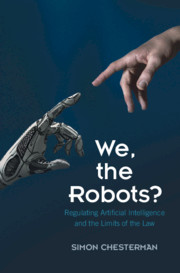7 - New Rules
from Part III - Possibilities
Published online by Cambridge University Press: 15 July 2021
Summary
As the preceding chapters demonstrate, existing norms, suitably interpreted, are able to deal with many of the challenges presented by AI. But not all. This chapter begins with a survey of guides, frameworks, and principles put forward by states, industry, and intergovernmental organizations. These diverse efforts have led to a broad consensus on half a dozen norms that might govern AI. Far less energy has gone into determining how these might be implemented – or if they are even necessary. Rather than contribute to norm proliferation, the chapter focuses on why regulation is necessary, when regulatory changes should be made, and how it would work in practice. Two specific areas for law reform address the weaponization and the victimization of AI. Regulations aimed at general AI are particularly difficult in that they confront many ‘unknown unknowns’, but uncontrollable or uncontainable AI could pose a threat far more serious than lethal autonomous weapon systems. Additionally, however, there will be a need to prohibit some conduct in which increasingly lifelike machines are the victims – comparable, perhaps, to animal cruelty laws.
Keywords
- Type
- Chapter
- Information
- We, the Robots?Regulating Artificial Intelligence and the Limits of the Law, pp. 173 - 194Publisher: Cambridge University PressPrint publication year: 2021

